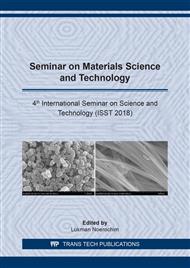[1]
Tapkire, G., & Parihar, S. (2014). Recycled Plastic Used in Concrete Paving Block. Bhopal, India: International Journal of Research in Engineering and Technology.
Google Scholar
[2]
Feng, Guyu. 2017. A comparative study on mechanical properties of surface modified polypropylene (PP) fabric reinforced concrete composites. China: Jiangnan University.
Google Scholar
[3]
Amran, Yusuf. 2015. Pemanfaatan Limbah Plastik Untuk Bahan Tambahan Pembuatan Paving Block Sebagai Alternatif Perkerasan pada Lahan Parkir di Universitas Muhammadiyah Metro. Lampung: Universitas Muhammadiyah Metro.
DOI: 10.35940/ijeat.f8744.088619
Google Scholar
[4]
Pratama, Dwiki. 2017 Studi Pengaruh Penambahan Binder Thermoplastic LDPE dan PET Terhadap Sifat Mekanik Komposit Partikulat Untuk Aplikasi Material Bangunan. Surabaya: Institut Teknologi Sepuluh Nopember.
DOI: 10.12962/j23373539.v7i1.28337
Google Scholar
[5]
Tjokordimuljo. 2007. Teknologi Beton. Yogyakarta: Biru Penerbit.
Google Scholar
[6]
Sulistijono. 2012. Mekanika Material Komposit. Surabaya: ITS Press.
Google Scholar
[7]
Billemeyer, Fred W. (1984). Textbook of Polymer Science. New York: John Wiley & Sons.
Google Scholar
[8]
Surdia, Tata. 1999. Pengetahuan Bahan Teknik. Jakarta: PT. Pradnya Paramita.
Google Scholar
[9]
Gulmine, J.V. et. al. 2002. Polyethylene characterization by FTIR. Brazil: Instituto de Tecnologia para o Desenvolvimento LACTEC.
Google Scholar
[10]
Krimm, S. 2013. Infrared Spectra of High Polymers. II. Polyethylene. Michigan: Randall Laboratory of pyhsics, university of michigan.
Google Scholar
[11]
Rjeb, A. 1999. IR Spectroscopy Study of Polypropylene Natural Aging.
Google Scholar
[12]
SNI 6882. 2014. Spesifikasi mortar untuk pekerjaan unit pasangan. Badan Standarisasi Nasional.
Google Scholar
[13]
Fadhil Kadhim, Lina. 2017. Studying The Properties of PP/LDPE Polymer Blend. Babylon university.
Google Scholar
[14]
ASTM D570. Standard Test Method for Water Absorption of Plastics Annual book of ASTM Standards,American Society for Testing and Materials (ASTM), Philadelphia, USA.
DOI: 10.1016/0043-1354(80)90051-2
Google Scholar
[15]
Ardi, Andi Wahyuni. 2016. Uji Kuat Tekan, Daya Serap Air dan Densitas Material Batu Bata Dengan Penambahan Agregat Limbah Botol Kaca. Makassar: UIN Almuddin Makassar.
DOI: 10.24252/jft.v6i2.11693
Google Scholar
[16]
Arif, Joksan. 2015. Pengaruh Resin Epoksi Terhadap Mortar Polimer Ditinjau dari Kuat Tekan, Kuat Tarik Belah, Daya Serap Air dan Scanning Electron Microscope. Lampung Jurusan Teknik Sipil Fakultas Teknik Universitas Lampung.
DOI: 10.22219/jmts.v12i1.2035
Google Scholar
[17]
Asthana, K. (2004). Development of polymer modified cementitious (polycem). Construction and Building Materials 18, 639-643.
DOI: 10.1016/j.conbuildmat.2004.04.037
Google Scholar
[18]
Wicaksono, Sigit Tri. 2018: Study on Mechanical and Physical Properties of Composite Materials with Recycled PET as Fillers for Paving Block Application. Surabaya: Institut Teknologi Sepuluh Nopember.
DOI: 10.1063/1.5030288
Google Scholar
[19]
Salih, E Sihama. 2012. Comparasion of the Characteristics of LDPE: PP and HDPE : PP Polymer Blends. Iraq: University of Thecnology, Materials Engineering Department.
Google Scholar


